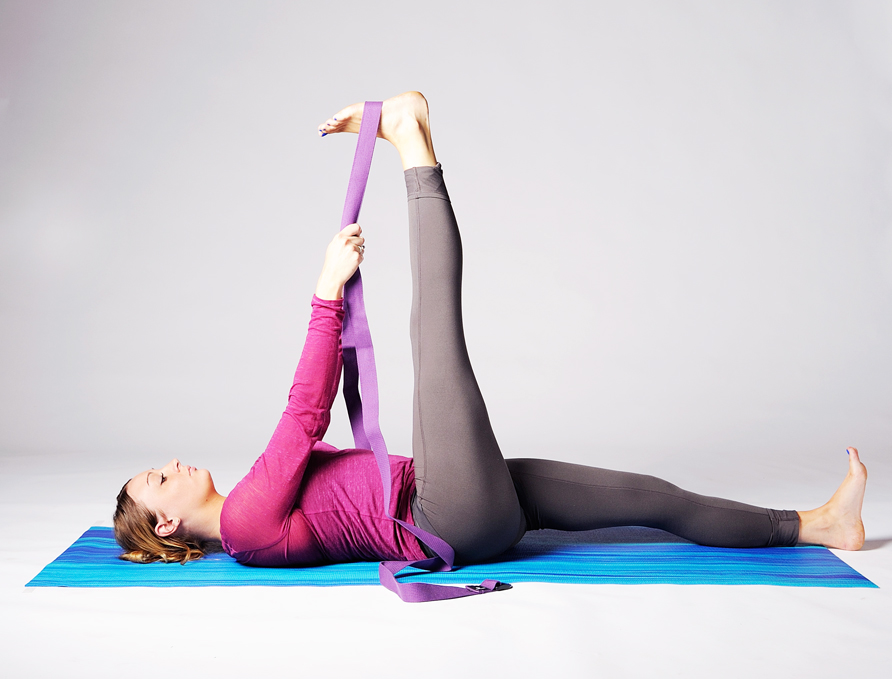
There are many reasons people decide to start practicing yoga. For me, it was simple curiosity, at least at first. Many of my students come to yoga to bring some calm to their lives. Some want to increase flexibility. A healthy percentage of my students originally came to practice hoping to resolve a physical issue, especially back pain. Whatever your intention, practicing yoga can indeed confer these benefits, along with other unexpected rewards.
Supta Padangusthasana (Supine Big Toe Pose) is one of my favorites for increasing mobility, helping alleviate back pain, and for helping connect students to the present moment. In 30-plus years of teaching, I’ve observed that the vast majority of students who come to yoga to help with back problems have issues with the discs between their lowest vertebral joints—L4/L5 and L5/S1 (the spaces between the fourth and fifth lumbar vertebrae and between the fifth lumbar vertebra and the sacrum).
When I observe these students, I almost always note a lack of mobility in the hips and hamstrings, so much so that when they bend forward, their pelvises don’t bend forward along with their spines. Instead, their pelvises tilt back, compressing the discs between the L4/L5 and L5/S1 joints.
A quick—and very important—fix is to instruct these students to bend their knees enough so that their pelvises can tilt forward along with their spines. I’m now teaching most forward bends with bent knees for everyone, even bendy people, in order to protect their hip joints, but that’s another story!
Supta Padangusthasana can provide a more long-lasting solution. Lying down to stretch your hamstrings gives you a constant reference point (the floor) to ensure you’re maintaining healthy spinal alignment. Using a strap allows you to find the perfect angle for your leg that allows you to keep it straight while keeping the rest of the body in structural integrity. Lying down, in itself, allows you to release tension more easily since most of your body is supported by the floor. This is key, because the process of lengthening is all about relaxing and letting go, rather than about pushing and forcing. Lying down naturally shifts us to a more easeful mindset.
This is not to say that people don’t sometimes push, force, grit their teeth and barely breathe in Supta Padangusthasana. But it seems to be easier to let go of these unnecessary tension patterns when you’re lying down.
How to Practice Supta Padangusthasana
- I like to practice Supta Pangusthasana using a wall because it provides additional alignment feedback. Lie down on your back on a yoga mat or blanket with your legs straight and resting on the floor.
- Place both feet into the wall, as if you’re standing on the wall. Draw your right knee in toward your chest, and then loop a yoga strap around the arch of your foot. Extend your leg to whatever angle allows your knee to be straight. This may be perpendicular to the floor, or it may be closer to your body or further away. Be sure to adjust your angle so that your left foot can still press evenly into the wall and so that your breathing is easy.
- Now check in with your upper body. Are your shoulders tense? Is your hand gripping your strap for dear life? Are you bugging your eyes out, furrowing your brow or clenching your jaw? If so, let go of all these unnecessary and unsustainable actions. Check your breathing. Does your abdomen easily rise and fall as you inhale and exhale? If not, you may need to adjust the angle of your leg to create less stress.
- As with every yoga asana, breathing is key. It is the key to giving your nervous system the go-ahead to allow the leg to release tension. It is also the key to keeping your mind in the moment-to-moment process of the asana.
- If you are holding your strap firmly but with ease—using it to connect with your leg rather than to force your leg closer to your body—and breathing deeply, you may notice that your leg wants to move away from you on the inhalation, and back toward your torso on the exhalation. Please allow both of these actions. Often the erroneous belief that yoga practice is about going further and further inhibits us from allowing our leg to move away on the inhalation. Disallowing this natural oscillation creates conflict between the body’s internal impulses and your outer actions. This conflict creates tension. Soften your grip on your strap and allow the oscillation of your right leg, even as you keep the left leg steady on the floor and the left foot pressing into the wall. Relax your brain and be fully present with the moment-to-moment process of oscillation.
- Take 10 or more deep breaths. Lower your leg to the floor to rest beside your left leg. Note what you feel. What has changed in your right leg? How does it compare to the left one?
It truly doesn’t matter how close you leg comes to your body in Supta Padangusthasana. If your leg never even makes it to vertical it’s really okay. The practice is not about accomplishing impressive feats of flexibility. The yoga is in each moment that you are aware of your breathing and your body’s response to it. Awareness is the practice.
I’ve come to realize that how we approach practice is far more powerful and transformative than what poses we choose to do. Whether you’ve come to practice to alleviate back pain, to gain mobility or to connect the body and mind, your presence is the most important element to connect you with a sustainable, life-supporting practice.
Updated article from June 17, 2015.
